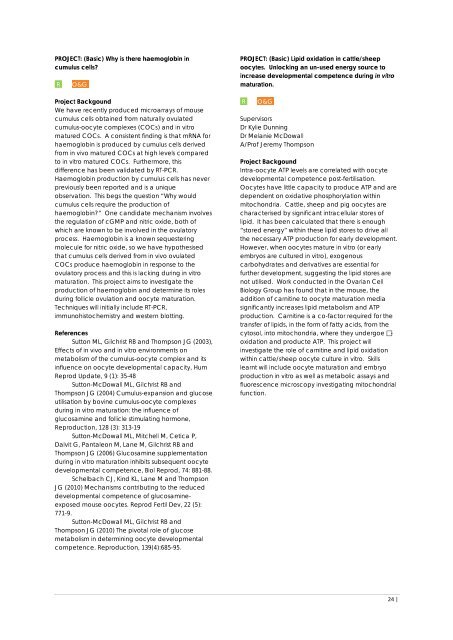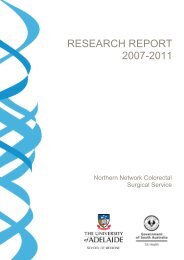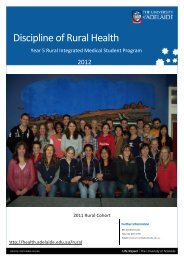Honours Project Book - Faculty of Health Sciences - University of ...
Honours Project Book - Faculty of Health Sciences - University of ...
Honours Project Book - Faculty of Health Sciences - University of ...
Create successful ePaper yourself
Turn your PDF publications into a flip-book with our unique Google optimized e-Paper software.
PROJECT: (Basic) Why is there haemoglobin in<br />
cumulus cells?<br />
R. O&G.<br />
<strong>Project</strong> Backgound<br />
We have recently produced microarrays <strong>of</strong> mouse<br />
cumulus cells obtained from naturally ovulated<br />
cumulus-oocyte complexes (COCs) and in vitro<br />
matured COCs. A consistent finding is that mRNA for<br />
haemoglobin is produced by cumulus cells derived<br />
from in vivo matured COCs at high levels compared<br />
to in vitro matured COCs. Furthermore, this<br />
difference has been validated by RT-PCR.<br />
Haemoglobin production by cumulus cells has never<br />
previously been reported and is a unique<br />
observation. This begs the question “Why would<br />
cumulus cells require the production <strong>of</strong><br />
haemoglobin?” One candidate mechanism involves<br />
the regulation <strong>of</strong> cGMP and nitric oxide, both <strong>of</strong><br />
which are known to be involved in the ovulatory<br />
process. Haemoglobin is a known sequestering<br />
molecule for nitric oxide, so we have hypothesised<br />
that cumulus cells derived from in vivo ovulated<br />
COCs produce haemoglobin in response to the<br />
ovulatory process and this is lacking during in vitro<br />
maturation. This project aims to investigate the<br />
production <strong>of</strong> haemoglobin and determine its roles<br />
during follicle ovulation and oocyte maturation.<br />
Techniques will initially include RT-PCR,<br />
immunohistochemistry and western blotting.<br />
References<br />
Sutton ML, Gilchrist RB and Thompson JG (2003),<br />
Effects <strong>of</strong> in vivo and in vitro environments on<br />
metabolism <strong>of</strong> the cumulus-oocyte complex and its<br />
influence on oocyte developmental capacity, Hum<br />
Reprod Update, 9 (1): 35-48<br />
Sutton-McDowall ML, Gilchrist RB and<br />
Thompson JG (2004) Cumulus-expansion and glucose<br />
utilisation by bovine cumulus-oocyte complexes<br />
during in vitro maturation: the influence <strong>of</strong><br />
glucosamine and follicle stimulating hormone,<br />
Reproduction, 128 (3): 313-19<br />
Sutton-McDowall ML, Mitchell M, Cetica P,<br />
Dalvit G, Pantaleon M, Lane M, Gilchrist RB and<br />
Thompson JG (2006) Glucosamine supplementation<br />
during in vitro maturation inhibits subsequent oocyte<br />
developmental competence, Biol Reprod, 74: 881-88.<br />
Schelbach CJ, Kind KL, Lane M and Thompson<br />
JG (2010) Mechanisms contributing to the reduced<br />
developmental competence <strong>of</strong> glucosamineexposed<br />
mouse oocytes. Reprod Fertil Dev, 22 (5):<br />
771-9.<br />
Sutton-McDowall ML, Gilchrist RB and<br />
Thompson JG (2010) The pivotal role <strong>of</strong> glucose<br />
metabolism in determining oocyte developmental<br />
competence. Reproduction, 139(4):685-95.<br />
PROJECT: (Basic) Lipid oxidation in cattle/sheep<br />
oocytes. Unlocking an un-used energy source to<br />
increase developmental competence during in vitro<br />
maturation.<br />
R. O&G.<br />
Supervisors<br />
Dr Kylie Dunning<br />
Dr Melanie McDowall<br />
A/Pr<strong>of</strong> Jeremy Thompson<br />
<strong>Project</strong> Backgound<br />
Intra-oocyte ATP levels are correlated with oocyte<br />
developmental competence post-fertilisation.<br />
Oocytes have little capacity to produce ATP and are<br />
dependent on oxidative phosphorylation within<br />
mitochondria. Cattle, sheep and pig oocytes are<br />
characterised by significant intracellular stores <strong>of</strong><br />
lipid. It has been calculated that there is enough<br />
“stored energy” within these lipid stores to drive all<br />
the necessary ATP production for early development.<br />
However, when oocytes mature in vitro (or early<br />
embryos are cultured in vitro), exogenous<br />
carbohydrates and derivatives are essential for<br />
further development, suggesting the lipid stores are<br />
not utilised. Work conducted in the Ovarian Cell<br />
Biology Group has found that in the mouse, the<br />
addition <strong>of</strong> carnitine to oocyte maturation media<br />
significantly increases lipid metabolism and ATP<br />
production. Carnitine is a co-factor required for the<br />
transfer <strong>of</strong> lipids, in the form <strong>of</strong> fatty acids, from the<br />
cytosol, into mitochondria, where they undergoe �oxidation<br />
and producte ATP. This project will<br />
investigate the role <strong>of</strong> carnitine and lipid oxidation<br />
within cattle/sheep oocyte culture in vitro. Skills<br />
learnt will include oocyte maturation and embryo<br />
production in vitro as well as metabolic assays and<br />
fluorescence microscopy investigating mitochondrial<br />
function.<br />
24 |





